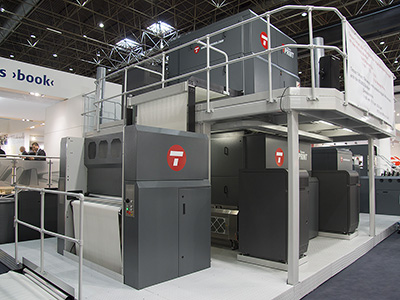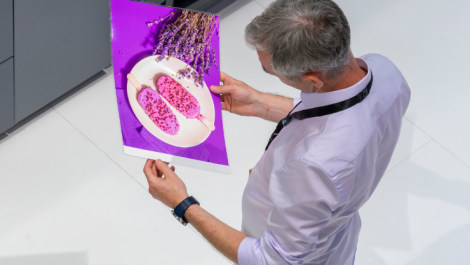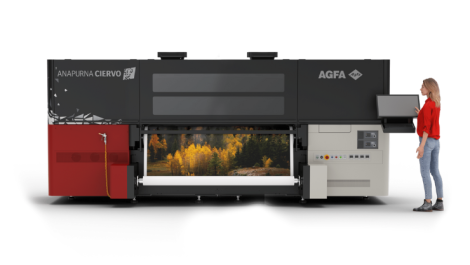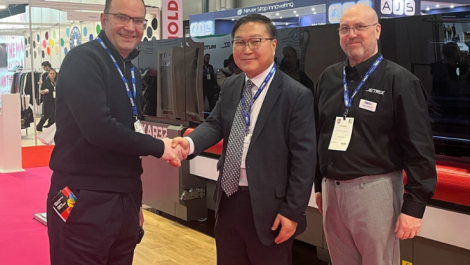Timsons T-Print.
Fast continuous feed digital printers offering high quality look like a game changer, not just for digital printing, but for printing in general, Nessan Cleary argues.
The market for continuous feed printers has been traditionally limited to transactional and some direct mail, with the latter mainly being printing variable data to pre-printed shells. But as the print quality of the machines available has improved over the years, people have started to talk about white paper solutions, cutting out the need to preprint logos and images.
Jo Oliphant, European continuous feed manager for Xerox, says the market for continuous feed printers is growing rapidly, saying ‘It’s probably one of the biggest growth areas in the entire digital market’. He puts this down to the ongoing desire to cut costs everywhere, pointing out that consolidating several smaller machines into one highly productive web device allows for savings across the board, with lower power consumption, fewer operators and less waste. He adds: ‘Even if the cost seems the same, you have the potential to do new things in the future.’
At Drupa we saw a large number of webfed digital presses, and although many of these won’t be available for another year or so, it’s obvious that they’re going to be very significant.
There are various markets, including books and direct mail, and even newspapers, but the main focus for most vendors is the transactional market and its associated transpromo application. As Craig Nethercott, business unit director of production printing for Océ UK, points out: ‘A transactional document is read and marketers understand that.’ However, the main issue with inkjet remains the image quality and the limited range of substrates that are suitable for high-speed inkjet, although we have seen a number of new stocks coming to market recently. Mr Nethercott says: ‘Inkjet can deliver the quality but you have to do it at an affordable price and that’s down to the amount of ink you lay down and the cost of the substrate. Also with postal prices going up people want to ensure that when they use direct mail it’s targeted and therefore it’s more about the message than the quality, and inkjet quality has improved.’
What’s available?
A few years ago Xerox pioneered a high speed toner technology for continuous engines, called flash fusing. This relies on flashing the light from a high-intensity Xenon light more than 2000 times a second to fuse the toner to the paper, rather than conventional heat fusing. This is very fast and results in crisp images with pages that come out flat with no post processing issues.
There’s a mono and a colour version, both available as single engines for simplex or twin engines for duplexing. The mono model is the Xerox 650/1300, which can produce 91.44 metres per minute or around 1232 A4 pages per minute. It has a maximum resolution of 1200 x 600 dpi. The colour model is the 490/980, which can run at up to 69 metres per minute, equivalent to around 900 A4 pages per minute. Resolution is 600 x 600 dpi.
The company also developed its own ‘waterless’ inkjet system, CiPress, which uses its own design of drop-on-demand printhead but with wax inks that are supplied and stored in granular solid form. It’s a highly refined descendent of the phaser technology originally developed for office printers by Tektronix, which Xerox acquired in 2000. The ink is melted to liquid form and jetted to the media. On hitting the cooler paper the inks immediately solidify, mostly sitting on top rather than penetrating far into the fibres.
This will work and give consistent appearance on many different types of paper, including inexpensive uncoated papers which are often used for toner or offset presses. Rival inkjet webs from the likes of HP, Kodak or Océ use aqueous inks with a high water content that has to be dried off the paper after printing. CiPress inks are in effect all pigment, so with no drying to worry about a lot more colour can be laid down. With no water distorting the paper, light weights down to 39 g/m2 can be printed.
Image quality of the CiPress 500 demonstrated at drupa wasn’t brilliant, but considering the low cost paper the results were more than acceptable. The inks are also suitable for standard offset de-inking methods, something that aqueous inkjets struggle with.
The original CiPress 500 has been joined by a slower version, CiPress 325, which runs at 100 metres per minute. However this slowdown bumps the resolution up to 600 x 600 dpi. For the price of a software license key you can upgrade to the faster 500 model. Pricing is about £2.2 million for the CiPress 500.
Another well-known player in the continuous feed market is Delphax. A few years ago it moved away from its traditional transactional market to expand into areas such as direct mail and book printing. Its CR series of fast continuous feed monochrome printers use proprietary electron beam imaging and dry toner technology. Models range from the CR1000 that can run at up to 70 metres per minute, up to the CR2200, which runs at 152 mpm. Resolution is 600 x 600 dpi across a web width of 463 mm.
Instead Delphax has developed a colour inkjet using Memjet heads. At drupa it showed this as the elan, a sheetfed SRA2 press. However Steve Hubbard, general manager of Delphax in Europe, says that a continuous feed version is being developed too, noting: ‘Web fed is the simplest way of producing a machine. Development time would be a fraction of the time taken for the elan.’
The company has also tested a hybrid using both toner and inkjet. Mr Hubbard explains: ‘Inkjet is not particularly good at very lightweight paper, so you could use toner for some work and the inkjet for higher quality.’
Océ was an early entrant into inkjet colour webs and now has two ranges, both using similar technology. Its JetStream models are built by Miyakoshi in Japan, though Crit Driessen, vice president of marketing and strategy, says that Océ contributed some of its own technology such as data integrity verification. There are several JetStream series, including Compact models with duplex printing in a single unit, the twin-engine Dual series, and a Wide series with a 749 mm print width.
At the end of last year three mono additions were announced in the Wide series: JetStream 2300, 3300 and 4300, for 100, 150 or 250 metres per minute. The colour 1900 Compact, with duplexing in a single tower, was announced at the same time. It’s runs at 127 metres per minute at 600 x 480 dpi, dropping to 100 mpm at 600 x 600 dpi.
Fujifilm announced the Jet Press W at Drupa, which has similar specifications and is based on the same Miyakoshi inkjet engine as the JetStream 1900 Compact.
Easing into colour
Océ’s other inkjet range is ColorStream, which it builds itself at its factory in Poing, Germany. These use the same inkjet engines as the JetStreams, but built into a chassis adapted from its VarioStream toner webs. ColorStream is designed to help customers move from mono to colour and can be configured with black or up to six colours including MICR. The footprint and paper direction is the same, whereas in JetStreams the paper direction is opposite to VarioStreams.
There are now two ColorStream models, the original 3500 running at 75 metres per minute and the new 3700, running at 100 metres per minute on a 540 mm web width.
Mr Driessen says there are no plans to abandon the JetStream series, whose more robust offset-like chassis is aimed at higher volume applications. Mr Nethercott also points out that Océ still has a significant installed base of toner devices not all applications are suitable for inkjet, he says: ‘The big market for toner will be security printing because of the amount of substrates that are involved.’
The web toner machines are called VarioStream: the mono 7000 series and the 8000 series with spot colours. These are simplex machines that can be twinned inline for duplex printing. The 7000 series prints up to 463.2 mm wide with speeds from 180 to 600 A4 pages per minute. The 8000 series has a print width of 495.3 mm, takes paper from 40 to 120 g/m2 and offers resolutions from 240 to 600 dpi. Speeds range from 500 up to 707 A4 pages per minute.
The related ColorStream 10000 Flex is a full colour toner press, with pricing and click rates to help customers start with monochrome and then migrate to colour.
Liquid toner
Océ has also developed InfiniStream, a web press using liquid toner technology. This is being built at Poing, where the company took some potential customers to see it during drupa in May. Initially it will be a simplex machine mainly aimed at the folding carton market. It runs at about 120 mpm with a 710 mm width, and should be available next year.
Liquid toner seems to be attracting quite a loot of attention as an alternative to aqueous inkjet, as it is potentially faster and isn’t as fussy about paper as there are fewer drying/fusing issues. We’ll look closer at how it works in the next issue.
Miyakoshi has had a liquid toner web press for several years and brought one to drupa, though it doesn’t seem interested in selling it in Europe. The same technology has been adapted into a sheetfed B2 press in partnership with Ryobi. A prototype was shown at drupa in Miyakoshi colours, running at a claimed 8000 sheets per hour (last month’s Digital Printer wrongly said it wasn’t there – we ran up against a language barrier).
Xeikon too has developed a continuous feed liquid toner printer called Trillium and showed a basic monochrome prototype at drupa, though the real thing will be full colour. It runs at 60 metres per hour but the company is confident it can double that. It will print on the same wide range of substrates as dry toner, which may give it an edge over some inkjet machines. Fine toner particles allow 1200 dpi yet low toner consumption.
HP also produces a webfed version of its Indigo press, which also uses liquid toner but in a different form to the Xeikon and Miyakoshi systems. The w7250 can print 240 A4 pages per minute in four colour mode, but because of the way that the Indigo presses work it’s faster with fewer colours, so that it can produce 960 pages in monochrome. As with other Indigo models, there’s room for up to seven colours. Resolution is up to 1219 dpi with 8-bit colour depth, with very good image quality for photobooks and the like.
This year HP has introduced Enhanced Print Mode for some models, which uses just cyan, magenta and yellow inks. In the w7250 this gives 320 ppm, with a small loss of quality.
HP’s thermal webs
HP first announced its T-series Inkjet Web Press at drupa 2008 and has been steadily installing these since 2009, with more than 60 now around the world. These use thermal inkjet heads adapted from office printers and are mainly used for book printing, direct mail and transactional work.
Earlier this year new versions were announced: the T360 with 762 mm web width and the new T410 for the wider 1067 mm platform. New printheads and new inks boost the speed to 244 metres per minute for both monochrome and full colour. Earlier T-presses can be upgraded to the samestandard from early next year.
HP has also upgraded its entry level compact mode. The T230 is twice as fast as the original T200 and now runs at up to 122 metres per minute in mono or colour.
Pitney Bowes has a worldwide exclusive deal to sell the T-series presses into transactional markets. It renames the presses IntelliStream, which are mechanically identical but fitted with PB front end software.
Screen was one of the pioneers of high speed inkjet for graphics work, having first shown its Truepress Jet520 as a prototype at Ipex 2006. These are simplex engines, so you need two for full-width duplexing, though there is a single engine duplex configuration that threads a half-width web through twice.
There are several variations, including the entry-level Jet520EX, also available as a mono version. The top of the range is the Jet520ZZ first seen last year. This runs at 220 metres per minute with a 520 mm web, equivalent to 173,280 A4 pages per hour. Screen also offers a wider version at 570 mm. Ricoh rebadges these presses as its Infoprint 5000 family, driving them from its own AFP workflow.
Three-pronged attack
Kodak has a long history of building continuous feed inkjets. It has three different inkjet technologies: the continuous flow heads used in its older Versamark transactional models, piezo drop-on-demand for the higher quality but slower Versamark VS series, and advanced continuous flow in the Stream heads used in its latest high speed high quality Prosper printers.
With Kodak now putting its consumer divisions up for sale, it’s bet the farm on a future that relies heavily on Stream/Prosper in commercial printing. So far its monochrome Prosper 1000 presses have done fairly well, mainly being used for book printing. The colour Prosper 5000 XL presses have fared less well, with only one beta site in Europe, at Howard Hunt. Another one installed at Servinform in Spain is being taken out again. However Will Mansfield, the director of inkjet printing, claims that a second one is being installed in the UK. He wouldn’t tell us where except to say it isn’t at Howard Hunt.
At drupa, Kodak announced the faster Prosper 6000XL, running at 304 metres per minute, though the quality drops to the equivalent of 133 lpi offset screening. Previously
it’s claimed that the 5000XL can reach the equivalent of 175 lpi, depending on a number of factors including the paper used.
A range of printhead modules has been developed using the same continuous inkjet technology as with the Prosper press. These are called S-series heads and are usually mounted on printing or finishing lines.
British giant book press
Timsons in Kettering has used the S-series technology to develop a huge monochrome inkjet printer aimed at the book market, called T-Press. This has a 1320 mm wide web width, which combined with a speed of 200 metres per minute, can produce around 240,000 A4 duplex pages per hour.
Kodak also sells the Versamark VL series of drop-on-demand inkjet printers, which are aimed at a very different market. They don’t offer the same image quality as the Prosper press but they are good enough for transpromo and some direct mail applications. There are three different models, the VL200, VL400 and VL600, which can print the full web width in simplex, or a half web duplex. Each also has a twin-engine configuration option that can print the full width of 474 mm in duplex. They use two Panasonic piezo heads, allowing two colours per head, although the VL600 uses four of these heads. Speeds range from 75 to 150 metre per minute with resolutions of 600 x 360 or 600 x 600 dpi.
Another up-and-coming player is the French company, Impika, which has been steadily developing an impressive range of high speed inkjets capable of very good image quality. At drupa it announced the new iPrint eXtreme, with Panasonic print heads. This has a 711 mm print width and can run at up to 375 metres per minute with a maximum resolution of 1200 dpi. Also new was iPrint Evolution, designed to be easily scaleable with extra printheads increasing the speed from 40 up to 250 mpm, with resolutions in four increments from 360 x 600 to 2400 x 1200 dpi. The third newcomer was iPrint Compact, a two-colour duplex model aimed at the transactional, transpromo and direct mail markets. It runs at 76 metres per minute with a single engine and very small footprint.
It’s also worth mentioning the Swiss developer Graph-tech, recently bought by Domino, which showed off an interesting monochrome printer at Drupa, called MonoCube. This is available in different widths, from 446 to 783 mm, and with speeds from 75 to 150 mpm, with an option to upgrade to the faster speeds at a later date. It can be simplex or duplex in the same unit, and simplex models can be upgraded to duplex. It includes a primer unit so that it can handle a wide range of papers. Resolution is 600 x 600 dpi and it uses very deep black inks from Toyo.
MonoCube uses technology that Graph-tech had originally developed as a forthcoming colour press for Nipson, which went into liquidation just before drupa. Nipson used a unique magnetographic imaging process with dry toner for fast monochrome transactional presses, but it didn’t survive long enough to move into inkjet colour.
Offset with digital
Given that many of the newer webfed printers are talking about white paper solutions to cut out the need for offset-printed shells (see pages 49-50 for instance), it’s not surprising that we are now seeing offset vendors developing high speed inkjet presses.
The nearest to market is probably KBA with its RotaJET76. This is a 76 cm wide press, aimed at commercial magazine and newspaper sectors as well as direct mail. It uses Kyocera printheads and runs at 150 metres per minute with a resolution of 600 dpi. It runs water-based pigment inks without any precoating, and will print to uncoated offset stock, though KBA recommends inkjet optimised papers for coated media.
As detailed in Digital Printer July, Benny Landa also announced that he would build three webfed presses using his Nanographic process, which can be thought of as waterless offset inkjet. These are designed to compete directly against offset presses, albeit in medium run lengths of thousands of copies rather than tens of thousands. They have a resolution of 600 x 600 dpi and run at 200 metres per minute. The heated offset belt means that no water reaches the paper, so standard offset grades should be usable.
The models announced at drupa include W5, a single sided press aimed at flexible packaging with a width of web 560 mm; the W10, a 1020 mm wide press aimed at packaging and general commercial work; and the W50, a duplexing press with a 560 mm web width aimed at the publishing markets.
Landa has signed deals with several offset vendors, including Komori (whose chassis underpinned the Landa prototypes at drupa), Heidelberg and manroland.
Komori has also developed a more conventional prototype webfed inkjet press called the Impremia iW20, which was shown running at drupa. It’s a four-colour press with a print width of 508 mm, running at 75 mpm at 1200 dpi or at 150 mpm at 600 dpi. It uses water-based inks with drying via a number of small IR bars across the print width.
Conclusion
As we have seen, there are several different competing technologies for the continuous feed market. Most vendors are betting on inkjet and aqueous inks, though it’s certainly going to be interesting to follow Landa, Xeikon and Xerox with their entirely different digital processes.
Many of the new devices shown at Drupa won’t be available for another year or so. In the meantime vendors that have bet on aqueous inkjet are hoping that the paper mills will develop inkjet optimised papers at a reasonable cost, which will help to increase print quality and open up more applications.





